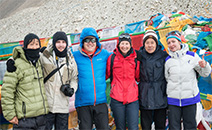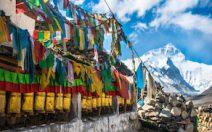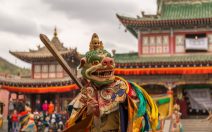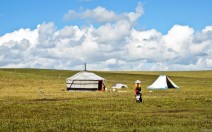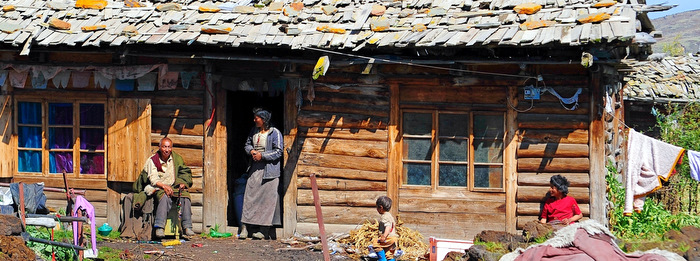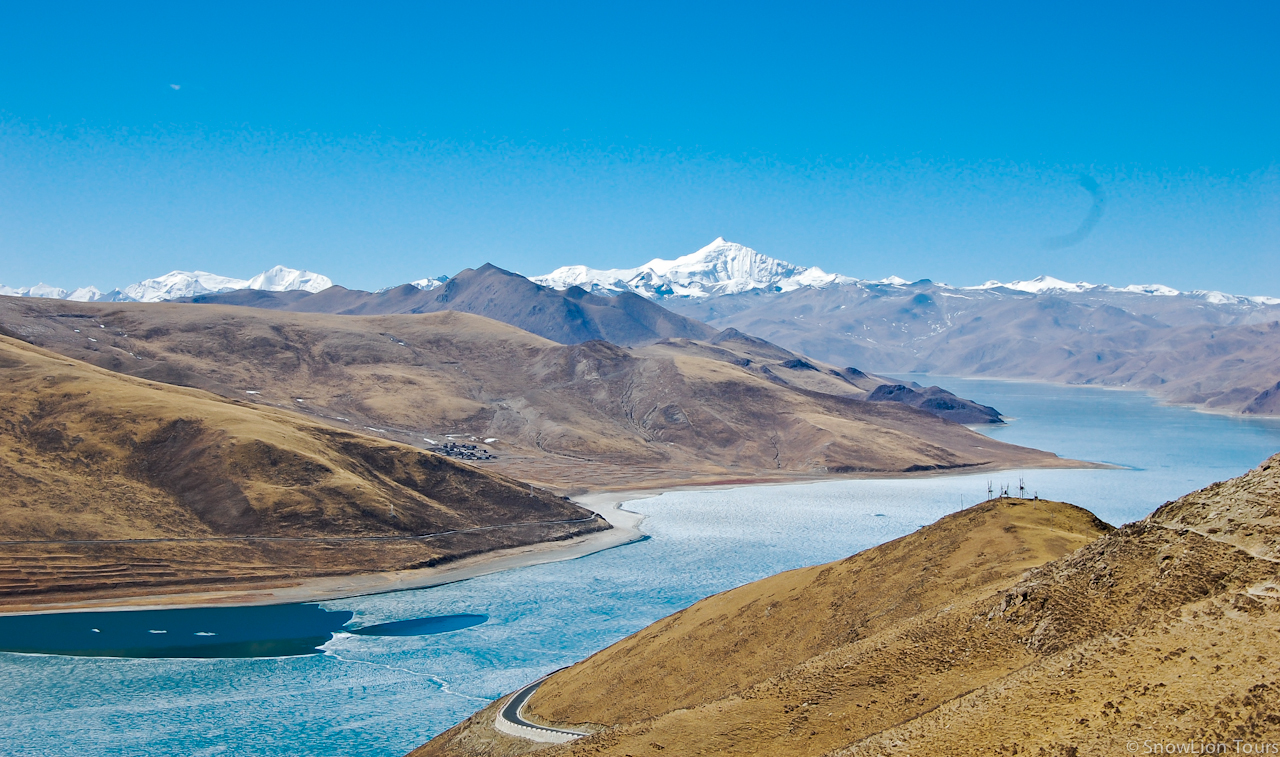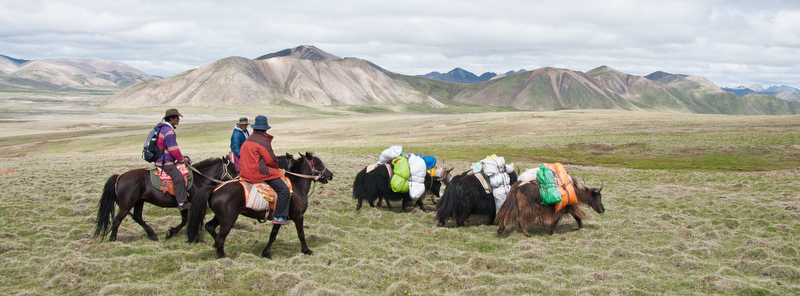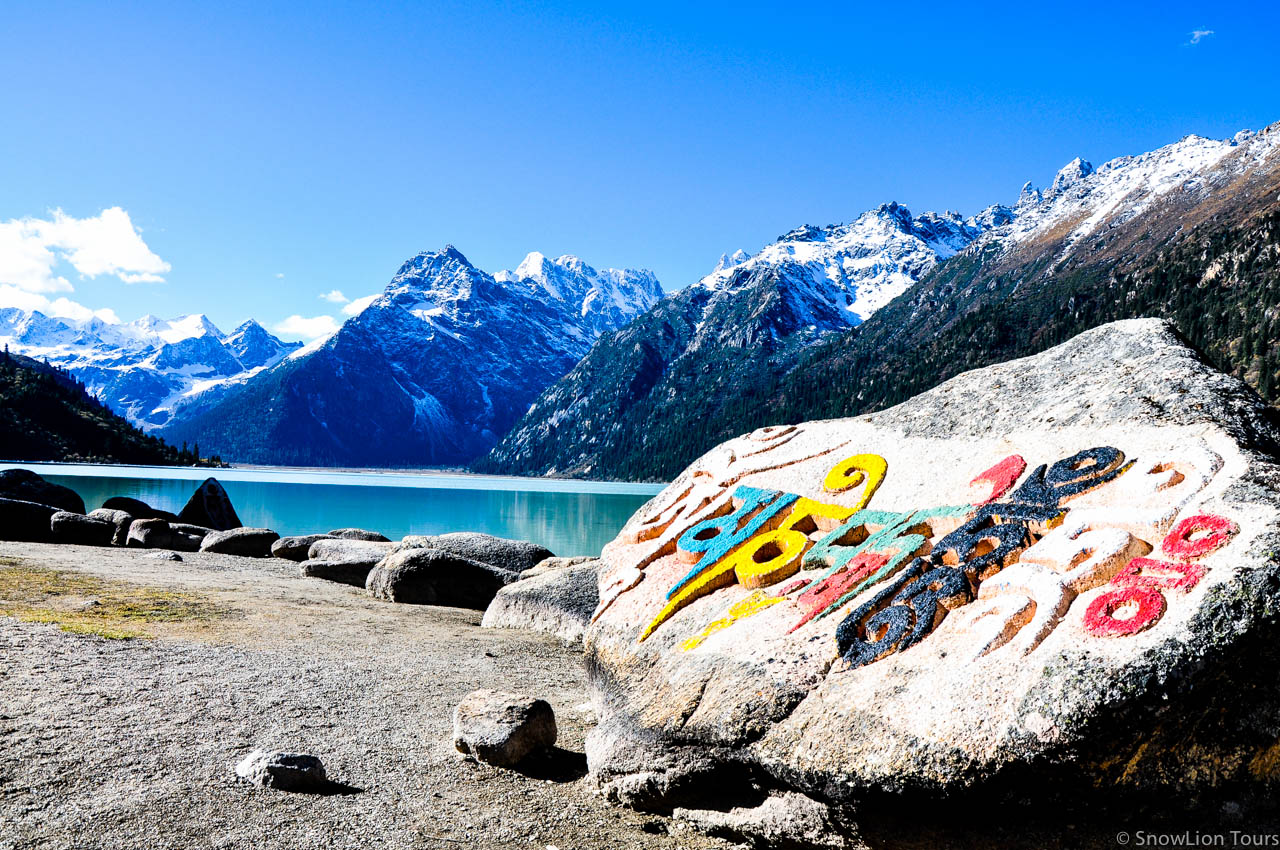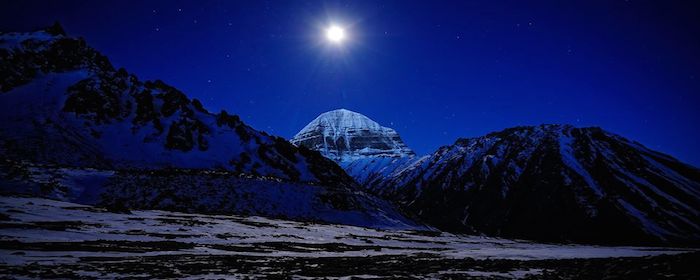Tibet Autonomous Region
Lhasa, the Tibetan capital, is located in U-Tsang. This central region of Tibet, which averages above 3600m, is home to the Potala Palace, Mt. Everest, holy lakes, medicinal hot springs, and many of the most famous monasteries in all of Tibet. Lhasa is one of the best places to get a glimpse of modern Tibetan life, while just outside the city many farmers and nomads persist in their traditional lifestyles. While most tourists visit Lhasa in the summer, the winter is an opportune time to see the colorful Tibetan capital. During the winter, pilgrims from all over Tibet flock to Lhasa to visit holy sites and enjoy the (relatively) warmer weather.
This incredible architecture of Tibet is named after the Mount Potalaka, the sacred mountain abode of the Bodhisattva of Compassion. The greatest monumental structure in all of Tibet. The Potala Palace is 13 stories high and holds countless treasures in its many rooms. Built in 637 AD, the Potala has been home to the Dalai Lama lineage for more than a thousand years. More info…
The Jokhang Temple is dedicated to the statue of Jowo Shakyamuni. This is the holiest temple in Tibet. Pilgrims from all over flock to this temple to catch a glimpse of the Jowo Buddha, a statue that is said to have been blessed by the Buddha himself. Some pilgrims even prostrate all the way to the temple, even if it takes them years to travel from their home village to Lhasa. More info…
Drepung Monastery and Nechung Temple
Drepung Monastery was funded in 1416 by Jamyang Choje Tashi Palden, one of the Tsongkhapa’s foremost disciples. This monastery houses more than 10.000 monks in it’s peak in 1641. Although there are just over 500 monks at the present day, but it is still the one of largest monasteries in Tibet. More info…
Mount Everest & Everest Base Camp
Mt. Everest also known as Chomolangma in Tibetan and Sagarmatha in Nepali located in the Mahalangur section of the Himalayas on the border between Tibet and Nepal. The Nepali side of Everest is called the the South Face and Tibetan side is called the North Face. The peak of Mount Everest rises at an elevation of 8848 m (29500 ft). Mount Everest is accompanied by a number of substantial peaks, including Lhotse (8,516 m/27,940 ft), Nuptse, (7,855 m/25,771 ft ), and Changtobse (7,580 m/24,870 ft). More info…
Namtso Lake & Tashidor Monastery
Namtso Lake also known as “Heavenly Lake” is located to the north of Lhasa and east end of Changtang Plateau. It’s the second largest salt lake in Tibet after Qinghai Lake / Lake Kukunor in Qinghai Province. Namtso Lake offers the beautiful vista of Tibetan Plateau you can imagine, the crystal clear lake is surrounded by the snow caped mountains and vast grasslands. More info…
Sera Monastery & Pabonka Hermitage
Sera Monastery་ or Sera Thekchenling is located on the northern outskirt of Lhasa City. The monastery was founded by Je Tsongkapa’s disciple Jamchen Choje Sakya Yeshe of Tse Gungtang (1355-1435) at the base of Mountain Purcbuchok in 1419. Even before this time, Tsongkapa, The founder of Gelug pa order in Tibetan Buddhism and his foremost students and disciples has established hermitages in the ridge above Sera Utse. More info…
The Sacred Lake Yamdrok Yumtso (4441m), means “ the lake of Turquoise”, situated around 100 km to the south of Lhasa. The paved road from Lhasa to Gyantse ascends to Kamba-la (4700m) pass. From the summit of Kamba-la, a stunning vista view appears before you: one side of the mountain is the bending of Yurlung Tsangpo (Brahmaputra River) valley and the other side is the Yamdrok lake, a freshwater lake which lies few hundreds meters below the road and the snow capped mountain Nojin Kangsang (7191m) in a distance. More info…
Gyantse (Gyantse Dzong, Pelkor Chode, Kumbum Stupa)
Gyantse Dzong was situated in the middle of Old Gyantse town, Rising up on a hill top. It is solid old fortress or old place for the local Kings of Gyantse from 13th century onwards. It was a strategic place which made some tough resistance for the British arm invasion in 1903. It is the tallest building in Gyantse which offers spectacular view from all the direction of the town. More info…
Drak Yangdzong, a sacred caves sight located in Dranang county south of Lhasa. This pilgrimage sight is associated with Guru Rinpoche, whose Buddha-body is represented by these caves. Drak Yangdzong is also an important place for treasure revelation, with both Padmasambhava and Yeshe Tsogyel both concealing treasures there. More info…
Chimpu Nunnery and Hermitage Caves
Chimpu or Chimphu hermitage cave is one of the most sacred place in Tibet. It is said to be the Indian master Guru Rinpoche’s speech. This is where the Indian Master taught the Twenty-Five Disciples and where numerous disciples had profound realizations. Today, there are still over 50 or more yogis, men and women, living in the cave and doing retreat. As we hike up to Chimphu and explore caves scattering at the mountain slope, there are many occasions to meet with them and make personal offerings. More info…
surphu monastery is located in 70km west of Lhasa, it is home to more than 300 monks. Tsurphu Monastery is famous for being the head of Kagyu tradition of Tibetan Buddhism as well as the seat of Karmapa. More info…
Ranwu Lake Rawok Lake, named Ngan-tso in Tibetan, it is located in the Ranwu town, Chamdo Prefercture of the Tibet Autonomous Region, about 127 kilometers from Bome county in the west and 90 kilometers from Baxoi County in the east. It is ranked as the largest lake in eastern Tibet, lies on the edge of National Road 318. More info…
__________________________________________________________________________________________
Amdo Tibet (Qinghai, Gansu and Sichuan)
he traditional Tibetan region of Amdo, is located on the northeast corner of the Tibetan Plateau. Though most of Amdo lies in modern day Qinghai province, large regions also are located in southwestern Gansu and northern Sichuan provinces. Roughly 1.6 million Tibetans live in Amdo which accounts for over 25% of the total Tibetan population. Amdo is famous for producing some of Tibet’s most famous spiritual leaders including Tsongkhapa, 14th Dalai Lama and the late 10th Panchen Lama. Amdo region is one the most beautiful area of Tibet, 80% of Amdo Tibetans are Nomads. Amdo offers great opportunities for photographing or recording grassland, nomads yak hair tents, snow mountains, lakes, yaks and sheep, blue skype, traditional life style, traditional songs,etc. There are also some famous monasteries in Tibet such as Kumbum Monastery, Rongwu Monastery, Labrang Monastery.etc.
Xining, known as Siling in Tibetan, is the start of the Qinghai-Tibet Railway and the gateway to the Amdo region of Tibet. Xining is the capital city of Qinghai Province and also main gate to travel overland to the remote region of Amdo and Kham places. more info…
Kumbum Monastery (Ch. Ta’er si)is one of the six great monasteries of the Gelugpa school of Tibetan Buddhism, is famous for being the birthplace of the great religious reformer Tsongkhapa. The full name is Kumbum Jampaling Monastery. It is a wonderful place to check out Tibetan religious culture, Tibetan architecture, and Tibetan art. More info…
Qinghai Lake is in the top 5 most beautiful lakes in China. The following photo is taken on the Island of the lake which is in the center of the lake. It is a Tibetan Buddhist retreat center as well as a small monastery on the top of this about football size island. More info…
Qinghai Tibetan Medical and Cultural Museum
Qinghai Tibetan Medical and Cultural Museum or Qinghai Tibet Cultural Museum was built in 2006. The purpose of this museum is to collect, preserve, display, and research the culture of Tibetan Medicine, Tibetan traditional culture and history overall. More info…
Rebkong is famous for it’s Tibetan traditional arts and cultural preservation. There are several monasteries and villages scattering around the Rongwu town which is home to hundreds of artists. The most well-known villages and monasteries are Sanggeshung Yago and Sanggeshung Mago(upper and lower Wutun), Gomar Gompa, Nyamtok village.etc. More info…
Labrang(Chi: Xiahe) town sprawls along the banks of Shangchu River(see above picture). It’s a one-street town and is predominantly Hui Muslims on the east side of the town and Tibetans at the west end. Labrang Monastery which is one of the Six great Monasteries in Tibet lays the edge of the west town at the north shore of Sangchu river. More info…
Full name: Gomang Gar Ganden Labsum Zungdjuk Dechenling. This is a branch of Labrang Monastery, housing around 600 monks. It was founded in 1776 (or in 1791) by the 2nd Jamyang Shepa, Konchok Jigme Wangpo. More info…
Golog Tibetan Autonomous Prefecture is located in the south of Qinghai Province at the Eastern edge of Tibetan Plateau. As it lies in the upper reach of Yellow River, this region also known as the Source of Yellow river. Golog is one of the biggest Tibetan Populated prefectures in Qinghai Province. More info…
Gui’de/Trika in Hainan Tibetan Prefecture
Gui’de or Trika in Tibetan is one of the lowest county in Qinghai Province. The elevation of Gui’de is 2200m / 7218ft. It is under the administration of Hainan Tibetan Prefecture. Geographically, it is located on the bank of Yellow River about 100 km southwest of Xining, the capital city of Qinghai Province and 150km southeast of Qinghai Lake south shore. More info…
Taktsang Lhamo or Langmusi is a small village located at the border of Gansu and Sichuan in the Amdo region of Tibet. the town is located in a beautiful peaceful valley surrounded by alpine forests and mountains. More info…
Qilian or Dola in Tibetan, known as the “Switzerland of the orient”, is county of Haibei Tibetan Prefecture in Qinghai Province, northern neighboring with first access of Hexi Corridor on Silk Road, therefor, it is “Northern Gate of Qinghai” known. More info…
A guide to Mount Amnye Machen & It’s Trekking Route
he Amnye Machen mountain range is located in the Golok Tibetan Autonomous Prefecture in Qinghai Province, traditionally this region belongs to Amdo Tibet. It is one of the four most sacred mountains in Tibet, the others are Mount Kailash in Western Tibet, Mount Minyak Gongkar in Sichuan Provice and Mount Karwa Karpo in Yunnan Province. It is revered by both Buddhists and Bon adherents. The protector deity Machen Pomra is said to reside in the mountain’s highest peak. The pilgrimage circuit around the mountain is popular among Bon followers and Buddhists as well as adventurous trekkers. More info…
Kanbula National Park (Khamra Park)
Kanbula National Park, in Tibetan its called Khamra. Located in west of Chentsa county in Huangnan Tibetan Autonomous Prefecture, 131km from Xining city, covering an area of 152 sq km and the park is famous for its unique land formation, red rocks, forest, vegetation, soaring peaks, and Tibetan temples are the main feature of the park. More info…
_________________________________________________________________________________________
Kham Tibet (Sichuan, Qinghai,Yunnan)
he Kham region of Tibet is located in the Chinese provinces of Sichuan, Tibet, Qinghai, and Yunnan. Kham is known for its verdant grasslands, craggy mountains, and pure rivers. The most famous Tibetan horse festivals such as Litang Horse Festival or Yushu Horse Festival take place every summer in Kham, where Tibetans compete and show off their riding skills. Tibetans from Kham have a reputation for being as loyal as they are tough. Many carry traditional swords and walk with a swagger, but are quick to invite you into their yak-hair tents for a cup of butter tea.
Kham is best for travelers interested in seeing wild Tibetan animals in their natural habitats, attending horse festivals, circumambulating the holy Mt. Kawa Karpo, staying with nomads, visiting small monasteries, camping, and bird watching in the forests.
Dege or Derge is often regarded the heart of Kham Tibet. It lies on the bank of Sugchu River, a tributary of Yantze River. It is administratively belong the the Ganzi prefecture of Sichuan Province. The town of Dege located next to Dege Gomchen and Parkhang(Dege Printer house) in the Sugchu valley. More info…
Pelyul or Baiyu county (3150m) is located in Ganzi prefecture in western Sichuan province. It is a large and rapidly expanding town with great number of Han Chines. The most Khampas with traditional Tibet clothes you see in town are on pilgrimage from outside town. More info…
Jyekundo or Yushu is a mojor Tibetan town located in Qinghai Province in the northwest region of Kham. Jyekundo town is found along the tributary of the Drichu (Tongtian He), which contribute to upper reach of mighty Yangtse River(Changjiang). More info…
Dzochen Monastery lies next to Dzochen township which is 140 km northwest of Ganzi County and 175 km southeast of Sershul/ Shiqu county. Driving through Dzochen township into the valley, the magnificent Dzochen monastery on a ridge and snow capped mountain Dorje Sultrom in distance come into view. More …
Ganzi County, also named Garze or Gantse is an ethnic Tibetan township and is located in the historical Tibetan region of Kham. Traditionally Ganzi belongs to one of the Horpa states in Horkhok region. Ganzi lies in the open Garzi valley at 3390m above sea level and is surrounded by rocky terrain and snow peaked mountains.he Yalong River’s tributary Rongcha River passes through the town from north to south. and county contains many Tibetan villages and monasteries. More…
Yachen Gar or officially called Yachen Orgyen Samtenling, is a nunnery located in Palyul of Ganzi Tibetan Autonomous Prefecture. It lies above 4000m high from sea level and the remoteness of this region made the nunnery isolated from outside for long time. More…
Sertar Larung Gar or Sertar Ngarig Buddhist Institute is a Buddhist academy located in the Larung valley. It was founded in 1980 by the Jigme Phuntsok, a Khenpo of Nyingma school of Tibetan Buddhism, it is a home to about 15000 monks and nuns, housing for monks and nuns divided by a winding road that divides the the Larung valley. Larung Gar is the largest and one of the highest Buddhist institute in the world. More info…
Nangchen is a county of the Yushu Tibetan Autonomous Prefecture and is the southernmost county-level division of Qinghai province, bordering the Tibet Autonomous Region to the south. It was one of the five kingdoms of the historical region of Kham. Nangchen town located in a side valley and on the right bank of the Dza Chu, upper reaches of the Mekong river. More info…
Danba or known as Rongdrak in Tibetan is one of the eighteen principalities or Kingdom(Queendom) of Gyelmo Rong or Gyelrong. The name Gyelmo Rong can be translated as Valley of the Queen, or “Queendom,” which hints at the significant history of the region having been ruled by women. “Gyelmo Tsawa Rong, meaning “The Hot Valley of the Queen in the East.” in Tibetan. More…
_________________________________________________________________________________________
Ngari / Ali Region (Western Tibet Autonomous Region)
Ngari is located in the far west of Tibet. The mountainous region, which is sparsely populated by nomadic tribes, is known as the “roof of the roof of the world,” as it averages about 4500m. It is home to Mt. Kailash and Lake Manasarova, known among Buddhists as the “Sacred Mountain and Holy Lake.” The mountain ruins of the Guge Kingdom, famous for their murals, sculptures, and stone inscriptions, are also located in Ngari. A mountain road connecting Ngari and Xinjiang makes it possible to drive from western Tibet to Kashgar.
Ngari is best for travelers interested in rugged adventure tourism, challenging trekking, seeing archaeological sites, circumambulating Mt. Kailash, observing local culture and folk customs, and visiting the most remote area of the Tibetan plateau.
Mount Kailash, which is known as Gang Rinpoche or the Precious Jewel of Snows in Tibetan, is considered by Buddhists to be the abode of the deity Chakrasamvara and by Hindu to be The Heaven of Shiva. The Jainism and Bon are also considered Mount Kailash as the holiest mountain in the world. More info…
Guge Kingdom / Tsaparang / Tsamda
The Guge Kingdom lies 25km north of Zhada County ( Other names: Tsamda, Zanda) and 15km from Tsaparang. This is one of the most important tourist site after Mount Kailash in far western Tibet. It takes about 3 – 4 days by and coveres almost 1500km one way from Lhasa by car. More info…
Toling Monastery / Zhada / Tsamda
Toling monastery was built in 997 AD by the second King of the Guge Kingdom – Yeshe -o when Toling as the capital city of Guge, and were constructed under the guidance of the great translator Rinchen Zangpo who traveled to Kashmir and India to study and translate with other 20 young monks. More info…
Burang, known as Purang in Tibet and Taklakot in Nepali, is a county of administration in Ngari Perfecture in the Tibet Autonomous Region. As its southwestern borders with Nepal and neighbors with India, so It’s a significant customs point between Tibet, India and Nepal. Nowadays, it’s a must-go place if tourist go west of Tibet to Visit Mt Kailash and Lake Manasarovar. More info…
Dungkar & Piyang Caves Temples
It’s about 60km from Zanda to Dungkar, located north from Toling at the small village of Dungkar and about 3 km away from Dungkar to Piyang. Dungkar and Piyang are famous for the wall painting and meditation caves, records shows there were more than 4,000 caves in the valley that was once inhabited. Nowadays, there are about 2000 caves remained at the Dungkar and Piyang. More info…
_________________________________________________________________________________________
Other Places in Northwest China
Dunhuang : Mogao Caves / Mingshashan / Ghost town
Dunhuang is a county-level city in Guansu province in north west China under administration of Jiuquan. Dunhuang’s name comes from its function as a garrison town of Han Dynasty, but the Tang name of Sha Zhou describes it better, hemmed in by bleak, pebbly desert and sand dunes. It was a important stop on the ancient Silk Road, passing through the remote garrison town of Loulan and through the Lop Desert. More info…
Zhangye: Dan Xia Colorful Land / Matisi / Dafo Si
Zhangye is originally called Gan Zhou, a city in northwestern part of Gansu province and middle in Hexi Corridor. Zhangye has many places to explore including Matisi, Danxia colorful Land, Giant Buddha Temple. More info…
